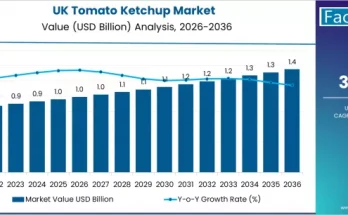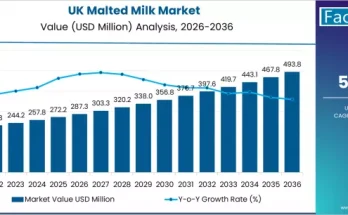The global marine protein market stands at the threshold of a transformative decade, marked by rapid expansion in health-driven nutrition, clean-label food innovation, and bioactive ingredient development. According to the latest research from Fact.MR, the market is poised to grow from USD 4,800.0 million in 2025 to USD 7,800.0 million by 2035, reflecting a robust CAGR of 4.9% over the forecast period.
As global consumers increasingly prioritize sustainable and functional protein sources, marine-derived proteins sourced from fish, shellfish, and algae are emerging as high-value ingredients in sports nutrition, functional foods, pharmaceuticals, and cosmetics.
Strategic Market Drivers
- Growing Health & Nutritional Awareness
Rising consumer focus on high-quality, easily digestible proteins is fueling the adoption of marine proteins. With superior amino acid profiles and bioavailability compared to plant and terrestrial animal sources, marine proteins are gaining traction in dietary supplements, performance nutrition, and clinical nutrition segments.
Moreover, the aging population and increased demand for collagen and gelatin peptides to support joint, skin, and bone health are accelerating product innovation among ingredient manufacturers.
- Expansion in Functional Foods and Beverages
Marine proteins are becoming essential components in functional food formulations, offering benefits such as emulsification, gelation, and water retention. Food and beverage companies are leveraging fish collagen peptides and hydrolysates for their texture-enhancing and nutritional properties.
The clean-label and sustainable sourcing trends are further driving demand for marine proteins as natural, non-GMO, and allergen-friendly alternatives to traditional protein ingredients.
- Rising Demand in Cosmetics and Personal Care
The cosmeceutical industry is rapidly integrating marine proteins—particularly marine collagen and elastin peptides—into anti-aging, moisturizing, and skin repair products. These bioactive compounds promote cellular regeneration and elasticity, appealing to consumers seeking natural and sustainable beauty solutions.
Manufacturers are investing heavily in marine-based bioactive extraction technologies, creating a new wave of eco-conscious skincare innovations.
Browse Full Report: https://www.factmr.com/report/marine-protein-market
Regional Growth Highlights
Europe: The Innovation Hub for Marine Bioactives
Europe leads the global marine protein market, supported by robust R&D investments, sustainable fishing regulations, and a strong presence of nutraceutical and personal care industries. Countries such as Norway, France, and Denmark are major production centers, focusing on marine collagen extraction and fish byproduct utilization to enhance sustainability.
North America: Rising Health and Sports Nutrition Demand
In the U.S. and Canada, marine proteins are gaining prominence in functional beverages, protein powders, and dietary supplements. The expanding sports nutrition industry and the surge in high-protein lifestyle diets are boosting the market.
Manufacturers are also introducing marine-sourced peptides and omega-rich proteins to cater to consumer preferences for traceable and eco-friendly ingredients.
Asia Pacific: Scaling Production and Consumption
Asia Pacific is emerging as a fast-growing region, driven by rising seafood processing capacity, government initiatives supporting circular economy practices, and increasing consumer adoption of protein supplements.
Countries like China, Japan, and South Korea are at the forefront of technological innovation, developing enzymatic hydrolysis and fermentation processes to improve protein yield and purity.
Latin America & Middle East: Expanding Utilization of Marine Resources
Regions such as Chile, Peru, and Saudi Arabia are witnessing growth through marine waste valorization and growing exports of hydrolyzed fish protein concentrate. Increasing collaboration between fisheries and biotech firms is expected to expand local market opportunities.
Market Segmentation Insights
By Source
- Fish Protein – Widely used for food and nutraceutical applications due to high bioavailability.
- Collagen and Gelatin from Marine Sources – Rapidly expanding across beauty, healthcare, and pharma formulations.
- Algae and Krill Protein – Emerging as sustainable and vegan-friendly alternatives.
By Application
- Nutraceuticals & Dietary Supplements – Major end-use driven by protein fortification trends.
- Food & Beverage Industry – Functional ingredient for processed and convenience foods.
- Cosmetics & Personal Care – Utilized in anti-aging, moisturizing, and repair formulations.
- Pharmaceuticals – Increasing application in drug delivery systems and wound healing.
Challenges and Market Considerations
Despite significant potential, the marine protein market faces hurdles such as:
- Supply Chain Complexity: Seasonal availability of raw materials affects cost and production stability.
- Sustainability Concerns: Overfishing and byproduct management necessitate stricter regulations and traceability.
- Processing Costs: High purification and extraction costs remain barriers for small manufacturers.
- Regulatory Compliance: Regional differences in labeling, sourcing, and functional claims require continuous adaptation.
Competitive Landscape
The market is characterized by technology-driven innovation and sustainability-led differentiation. Leading players are focusing on biotechnological advancements, circular economy practices, and product diversification to strengthen their global presence.
Key Players in the Marine Protein Market
- Rousselot
- Nitta Gelatin
- Gelita
- Seagarden
- Weishardt
- PB Leiner
- Amicogen
- Copalis
- Marine Ingredients
- Hangzhou Nutrition
- Golden Omega
- Norland
- Collagen Matrix
- Taia
- Vital Proteins
Recent Developments
- 2023 – Rousselot launched Peptan® Marine Collagen Peptides, enhancing clean-label offerings for joint and skin health.
- 2022 – PB Leiner expanded its fish collagen facility in France to boost sustainable collagen production.
- 2022 – Seagarden unveiled a new hydrolyzed fish protein concentrate line for high-performance food applications.
Future Outlook: Blue Biotechnology and Circular Innovation Lead the Way
The next decade will redefine the marine protein industry with blue biotechnology, AI-driven bioprocessing, and upcycled marine ingredients. Manufacturers are expected to focus on zero-waste processing, advanced hydrolysis techniques, and bioactive discovery to meet global sustainability goals.
As consumers shift toward ocean-friendly, functional, and ethical nutrition, the marine protein market is set to play a pivotal role in the future of global protein supply chains—bridging the gap between performance, sustainability, and innovation.



